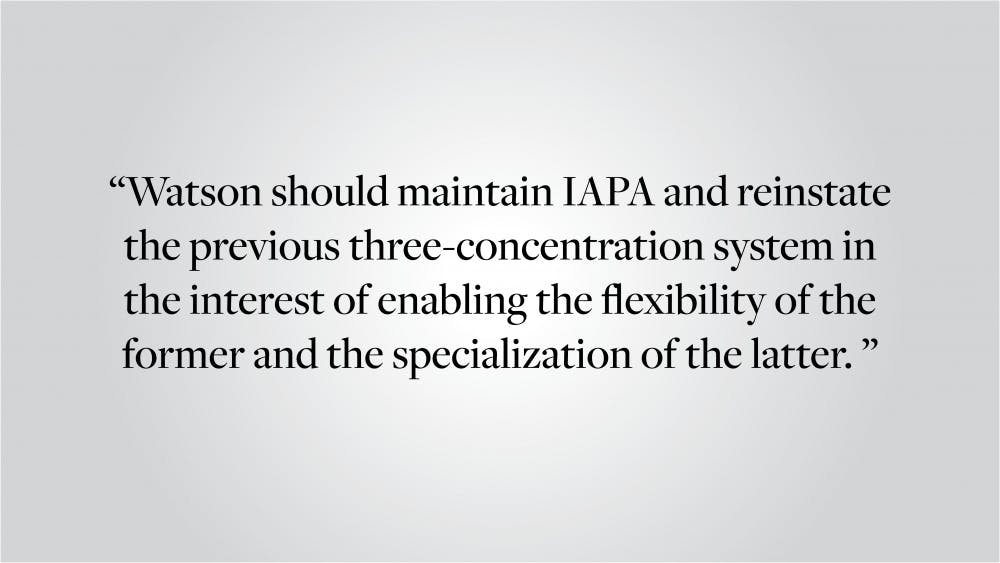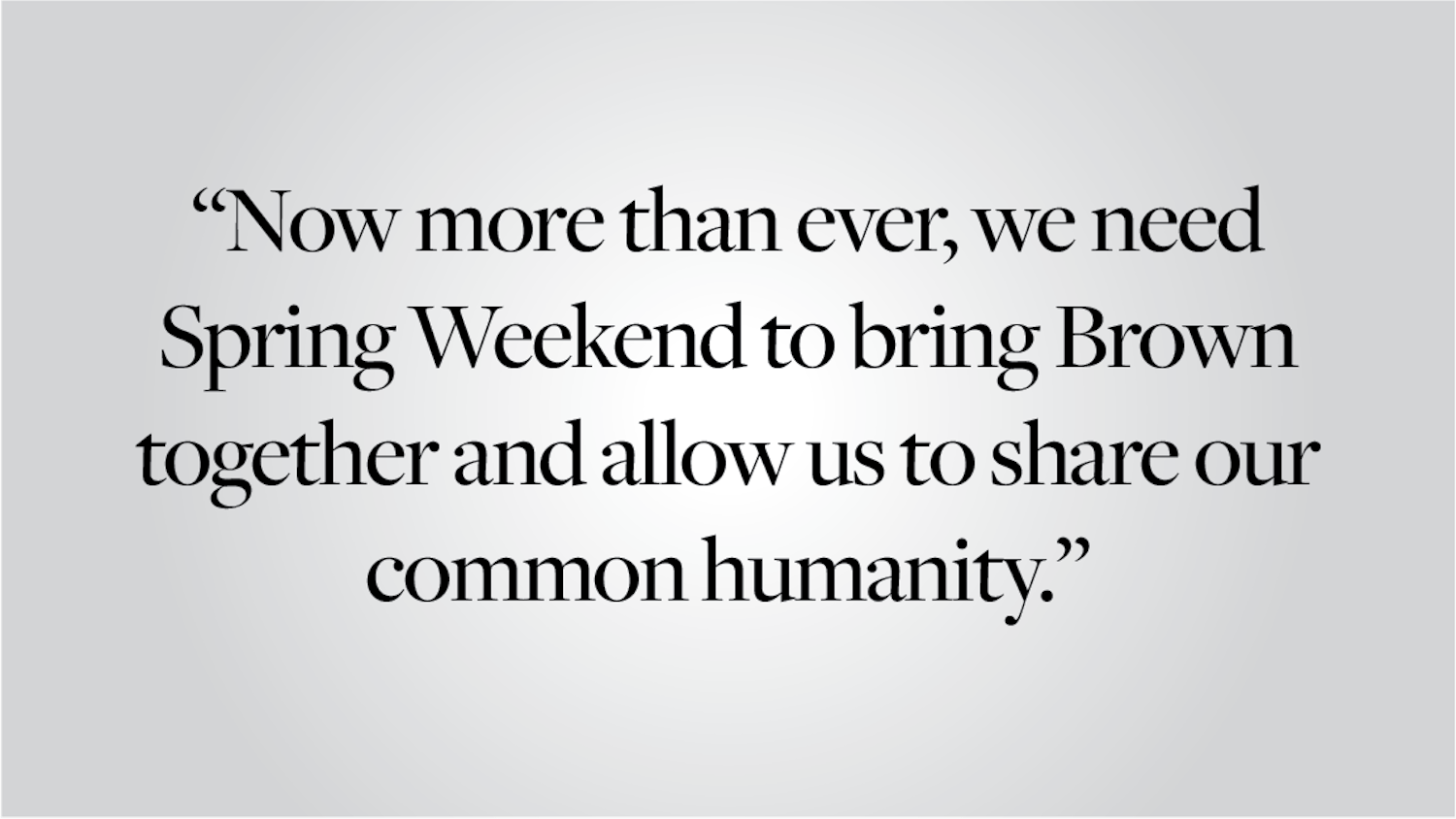“Do you pronounce it I-A-P-A or I-APA?” This conversation with my fellow International Relations concentrators was a lighthearted way of passing the time. But questioning IAPA’s pronunciation illustrated how the Watson Institute had transformed over the past year.
In April 2019, the Watson Institute officially announced that it was going to combine its three main concentrations — International Relations, Public Policy and Development Studies — into one: International and Public Affairs. In its official statement, the Watson Institute stood by the decision, claiming that the new program would “offer students the best, most globally relevant liberal arts education possible.” The transition drew criticism, with Professor Nina Tannenwald, head of the IR program at the time that the merger was proposed, noting her objection to the plan. While IAPA solved many of the problems posed by the old, three-concentration system, the new structure is not without its shortcomings. Watson should thus maintain IAPA and reinstate the previous three-concentration system in the interest of enabling both the flexibility of the former and the specialization of the latter. The success of this transition rests on transparency and the active solicitation of student input.
With regard to specialization, IR, PLCY and DS truly shine. IR’s original mission was to develop “analytic tools, language expertise and cross-cultural understanding,” whereas PLCY is focused on studying the “design, implementation and evaluation of better policies and practices.” The Watson Institute’s website states that the primary aim of the DS curriculum is to train students to “engage with the issues of economic and social development.” In each of these three concentrations, there was a comprehensive structure in place to guide first-years through the discipline and the Open Curriculum as a whole.
Moreover, the core coursework of the three previous concentrations allowed students to develop the key knowledge relevant to their fields. The interdisciplinary nature of IR was emphasized in coursework in Anthropology, Economics, History, Sociology and Political Science. In PLCY, concentrators learned about what issues policy-makers grapple with through Ethics for Public Policy and Program Evaluation. DS leaned into its economic background, requiring a course in Developmental Economics and a special sophomore seminar. In each of the three, concentrators gained a tailored skillset.
IAPA adopts a more generalist approach, intending to instill students with “knowledge and skills necessary for engaged global citizenship.” Meant to resemble a combination of the prior three, it features three separate tracks: Development, Security and Policy & Governance. Each track’s five electives can be chosen in specific areas, and the concentration drops the language requirement of IR and DS and the stricter methods requirements of the previous concentrations — thus balancing flexibility and specialization.
But while IAPA offers flexibility, students who wish to specialize in the vein of the previous concentrations miss out on this opportunity. By both preserving IAPA and reinstating the previous three concentrations, students could choose between flexibility and specialization, rather than being forced into one.
The language requirement of DS and IR and IAPA’s notable lack thereof, for example, speaks to the need to offer all four concentrations. Language requirements certainly have practical benefits. When IAPA removed the language requirement featured in IR and DS, it diluted the global focus of the program’s internationally-based education. Language courses added a culturally immersive dimension to DS and IR while teaching applicable skills. In the absence of a requirement, fewer people will study languages independent of the concentration, thus losing this unique element.
At the same time, though, the old language requirement might pose a barrier to entry for students who enter Brown without Advanced Placement credits, putting them at a disadvantage against students who place out of language courses and thereby face a smaller course load. Moreover, IAPA could encourage students to specialize in a greater array of regions, such as South Asia, Southeast Asia, and West Africa, given that AP classes disproportionately represent European language-speaking regions.
On the other hand, the prior three distinct concentrations give students an edge in their job searches by instilling in them important skills unique to their field. In order to be a competitive applicant, IR concentrators need fluency in a language other than English and a strong sense of cultural familiarity. PLCY concentrators need to have a firm basis for evaluating and assessing policies, which they gain through a program evaluation requirement. DS concentrators need to understand the economic and sociological theories of development, perspectives they develop through their unique and specialized core courses. Without being forced to develop these skills, IAPA graduates could be passed over for students from other schools that require language proficiency and such specialized skills. To be clear, IAPA’s flexible structure doesn’t mean that students won’t develop these same skills. What it does mean is that they are not guaranteed to learn them.
Still, IAPA’s flexibility welcomes prospective double concentrators who prefer the concentration’s less structured requirements, as compared to the previous system. I’ve had plenty of friends studying subjects like Computer Science and Applied Mathematics who appreciate IAPA as an additional concentration because of its flexibility. By creating a Watson with all four concentrations, the institute could expand its offerings to students in all degree programs.
If the prior three concentrations are reinstated, reform must follow. Watson should distribute and publish a yearly survey to collect student feedback and assess the status of the merger. There’s little data beyond anecdotes about how current and incoming Watson concentrators feel now that the IAPA has settled into the Open Curriculum. In fact, while Watson Director Edward Steinfeld emphasized that the merger was developed with substantial student and faculty input, the development and passage of the IAPA proposal remains opaque. Feedback and transparency are essential to the program’s success.
If the Watson Institute wants to achieve its initial goal and “offer students the best, most globally relevant liberal arts education possible,” it must make up for the gaps left by the elimination of IR, PLCY and DS. Propping up IAPA as Watson’s sole concentration addresses certain problems with the old curriculum, yet major shortcomings arise relating to specialization, the content of coursework and career preparedness. All four concentrations should be kept to maximize student choice. Watson should avoid unilateral decision-making by soliciting and valuing student feedback, thereby promoting transparency in the institute as a whole — and providing students with the most intellectually stimulating academic program possible.
Deepak Gupta ’22 can be reached at deepak_gupta@brown.edu. Please send responses to this opinion to letters@browndailyherald.com and op-eds to opinions@browndailyherald.com.





